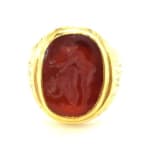Gold Ring Featuring a Classical Revival Carnelian Intaglio of Two Lovers, 18th Century CE
Carnelian-Gold
FJ.6729
Further images
This Antique Seal Has Been Set in a Modern 18 Karat Gold Rin The art of glyptics, or carving images on colored precious stones, is probably one of the oldest...
This Antique Seal Has Been Set in a Modern 18 Karat Gold Rin
The art of glyptics, or carving images on colored precious stones, is probably one of the oldest known to humanity. Intaglios, gems with an incised design, were made as early as the fourth and third millennia B.C. in Mesopotamia and the Aegean Islands. They exhibit a virtuosity of execution that suggests an old and stable tradition rooted in the earliest centuries. The tools required for carving gems were simple: a wheel with a belt-drive and a set of drills. Abrasives were necessary since the minerals used were too hard for a metal edge. A special difficulty of engraving intaglios, aside from their miniature size, was that the master had to work with a mirror-image in mind.
The Classical Revival was a phenomenon that swept across Europe during the 18th and 19th Centuries. A new appreciation for antiquity and ancient art forms was fostered by discoveries in the nascent scientific field of archaeology. Perhaps the Classical Revival also reveals a latent longing towards the Arcadian lifestyles of yesterday abandoned as Europe became rapidly industrialized and increasingly urbanized. On this stunning intaglio, a pair of lovers is represented joined in an intimate embrace. The ribald subject matter is typical of the Classical era where morals were relaxed and sexuality was openly flaunted without guilt or hesitance. Today, this seal might appear shocking, as it surely did when it was carved; however, this image is not offensive, instead it is a link to the past through an action that is as old and eternal as mankind itself.
The art of glyptics, or carving images on colored precious stones, is probably one of the oldest known to humanity. Intaglios, gems with an incised design, were made as early as the fourth and third millennia B.C. in Mesopotamia and the Aegean Islands. They exhibit a virtuosity of execution that suggests an old and stable tradition rooted in the earliest centuries. The tools required for carving gems were simple: a wheel with a belt-drive and a set of drills. Abrasives were necessary since the minerals used were too hard for a metal edge. A special difficulty of engraving intaglios, aside from their miniature size, was that the master had to work with a mirror-image in mind.
The Classical Revival was a phenomenon that swept across Europe during the 18th and 19th Centuries. A new appreciation for antiquity and ancient art forms was fostered by discoveries in the nascent scientific field of archaeology. Perhaps the Classical Revival also reveals a latent longing towards the Arcadian lifestyles of yesterday abandoned as Europe became rapidly industrialized and increasingly urbanized. On this stunning intaglio, a pair of lovers is represented joined in an intimate embrace. The ribald subject matter is typical of the Classical era where morals were relaxed and sexuality was openly flaunted without guilt or hesitance. Today, this seal might appear shocking, as it surely did when it was carved; however, this image is not offensive, instead it is a link to the past through an action that is as old and eternal as mankind itself.





